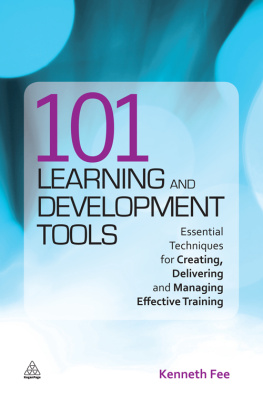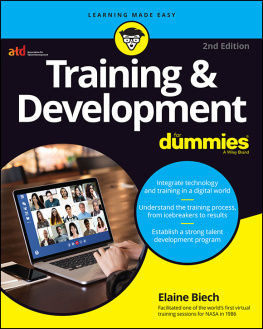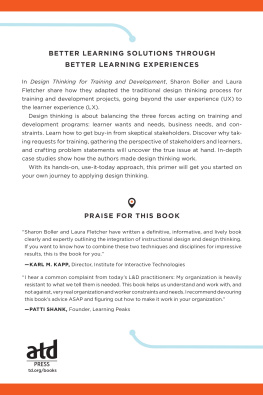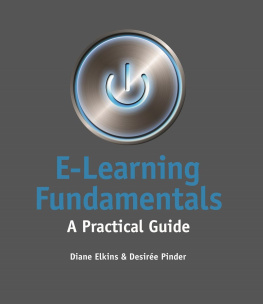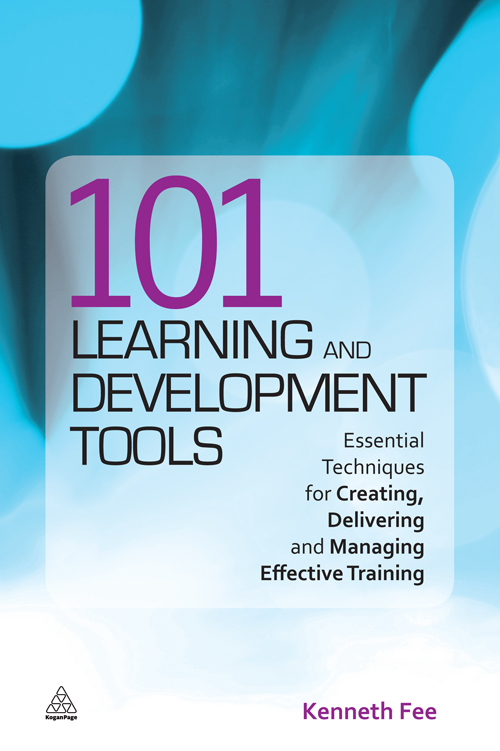Note on the Ebook Edition For an optimal reading experience, please view large
tables and figures in landscape mode. |
This ebook published in 2011 by
Kogan Page Limited
120 Pentonville Road
London N1 9JN
UK
www.koganpage.com
Kenneth Fee, 2011
E-ISBN 978 0 7494 6109 6
CONTENTS
Format of entries |
The learning and development cycle |
Performance analysis quadrant |
The learning curve |
Kolbs experiential learning cycle |
Johari window |
The learning value chain |
The talent web |
The succession planning cycle |
Learning methods choice matrix |
Criteria for choosing a learning approach |
Outsourcing/insourcing matrix |
The three component parts of e-learning |
The route map model for e-learning design |
Appreciative inquiry |
The GE nine box model |
Quality assurance: the diamond model |
ROI formula |
Kirkpatricks four levels of evaluation |
Balanced scorecard |
The e-learning impact matrix |
Competence grid |
Barriers to learning |
Senges dimensions of a learning culture |
Data, information and knowledge |
Learning methods and styles grid |
The five models of e-learning |
Costing learning |
Measures in evaluating learning |
Kenneth Fee has worked in learning and development for 25 years, as a trainer, consultant, manager and writer, among other roles. He has an MA degree in social science, an MBA, certificates in training and in assessment, and a professional diploma in training management. He is a chartered fellow of CIPD and a fellow of CMI.
His previous books include A Guide to Management Development Techniques and Delivering E-Learning , both published by Kogan Page. Since 2007, he has written a blog at http://learnforeverblog.blogspot.com.
He lives in Lanarkshire, Scotland, United Kingdom, with his wife and son.
T his work contains reference to a large number of tools and techniques originating from other sources. Thanks are due to the following (or their estates, where applicable) and their publishers: Malcolm Knowles for his theory of andragogy, Stewart Hase for his theory of heutagogy, Roger W Sperry for left versus right brain, George A Kelly for his repertory grid, Benjamin Bloom for his taxonomy of learning domains, David A Kolb for his experiential learning cycle, Peter Honey and Alan Mumford for their learning styles model, Colin Rose for his learning styles model and for accelerated learning, Joseph Luft and Harry Ingham for the Johari window, Michael Porter for his value chain, Peter Senge for his fifth discipline and its application to learning cultures and the learning organization, Mike Pedler, John Burgoyne and Tom Boydell for their definition of a learning organization, Daniel Goleman for emotional intelligence, Howard Gardner for his multiple intelligences, Richard Bandler and John Grinder for neuro-linguistic programming, Mick Cope for his structural model of the management of knowledge, Andy Cross for the talent web, David Clutterbuck for his learning alliances, Bob Aubrey and Paul Cohen for their five skills of mentoring, Roberto Moretti for his practice-made-perfect system, Reginald Revans for action learning, Etienne Wenger for communities of practice, Donald Kirkpatrick for his four levels of evaluation, Kaliym Islam for his application of Six Sigma to training and development, and all the authors and publishers whose works are cited in this book. Thanks as well to the Boston Consulting Group for their growth share matrix, the Chartered Institute of Personnel and Development for their partnership of learning model, General Electric and McKinsey for the GE nine box model, Motorola Incorporated for Six Sigma, NHS Education for Scotland for the diamond model of quality assuring continuous professional development, Volunteer Development Scotland for VSkills, and the Wizards Network for the chocolate factory.
The author would also like to thank the following for their suggestions and advice: Hannah Berry, Peter Farr, Karen Fee, Elizabeth Holden, Lindsay Officer, Martyn Sloman, Matthew Smith, and everyone who responded to discussion topics initiated in groups on LinkedIn, and followed posts on the learnforever blog, http://learnforeverblog.blogspot.com .
Lindsays story
Lindsay didnt always want to work in human resources; very few young people do. Her interest in business was first sparked at school, when she took part in a young entrepreneurs competition, in the role of deputy personnel director, but it was only after graduating with an English degree, qualified for nothing but teaching or academia, that she reviewed her vocational options and chose to study for a postgraduate Masters degree in HR.
On qualifying, she lacked experience, having undertaken only a short student placement in an HR generalist role, but after temping in administrative positions for a few months she was able to secure a position as training and development coordinator for an oil industry support company. Lindsays responsibilities included administering training courses for 600 offshore oil workers, and occasionally helping with administration in employee relations issues.
This gave her a start, and she was able to move on, after two years, to the post of HR and training manager for a large hotel, part of a well-known chain. This was mainly a generalist role, beset by an industry sector problem of recruiting low-skilled employees, earning minimum wage, to jobs where they rarely stayed long. Lindsay found herself undertaking a lot of recruitment, managing staff shortages even to the extent of helping out with waitressing and handling many disciplinary procedures. Despite some interesting work in training and in health and safety, Lindsay found the long working hours and lack of opportunity to develop staff frustrating, and within three years made another move, this time to a much better role.
The post of HR adviser in the employee development team of a local authority proved to offer a much more varied range of work, and four years on she still holds this position. Her responsibilities include considering development needs, sourcing training from external providers, delivering face-to-face training in subjects like team building, performance management and leading change, and writing e-learning courses.
Lindsay enjoys using her interpersonal skills in a more positive way, meeting peoples needs and maintaining a customer focus. She relishes opportunities to exercise her creativity when designing training courses and online learning. She is a little concerned about the decay of her generalist skills and up-to-date knowledge of employment law, as she concentrates more and more on learning and development. And she finds her career very demanding. But overall she still describes HR as her dream job and maintains she would recommend it to anyone.
What follows is aimed primarily at people like Lindsay.

